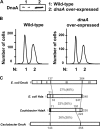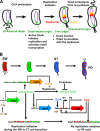Feedback control of DnaA-mediated replication initiation by replisome-associated HdaA protein in Caulobacter
- PMID: 19633089
- PMCID: PMC2737981
- DOI: 10.1128/JB.00525-09
Feedback control of DnaA-mediated replication initiation by replisome-associated HdaA protein in Caulobacter
Abstract
Chromosome replication in Caulobacter crescentus is tightly regulated to ensure that initiation occurs at the right time and only once during the cell cycle. The timing of replication initiation is controlled by both CtrA and DnaA. CtrA binds to and silences the origin. Upon the clearance of CtrA from the cell, the DnaA protein accumulates and allows loading of the replisome at the origin. Here, we identify an additional layer of replication initiation control that is mediated by the HdaA protein. In Escherichia coli, the Hda protein inactivates DnaA after replication initiation. We show that the Caulobacter HdaA homologue is necessary to restrict the initiation of DNA replication to only once per cell cycle and that it dynamically colocalizes with the replisome throughout the cell cycle. Moreover, the transcription of hdaA is directly activated by DnaA, providing a robust feedback regulatory mechanism that adjusts the levels of HdaA to inactivate DnaA.
Figures






Similar articles
-
The Caulobacter crescentus Homolog of DnaA (HdaA) Also Regulates the Proteolysis of the Replication Initiator Protein DnaA.J Bacteriol. 2015 Nov;197(22):3521-32. doi: 10.1128/JB.00460-15. Epub 2015 Aug 31. J Bacteriol. 2015. PMID: 26324449 Free PMC article.
-
DnaA coordinates replication initiation and cell cycle transcription in Caulobacter crescentus.Mol Microbiol. 2005 Dec;58(5):1340-53. doi: 10.1111/j.1365-2958.2005.04912.x. Mol Microbiol. 2005. PMID: 16313620
-
Regulation of the activity of the dual-function DnaA protein in Caulobacter crescentus.PLoS One. 2011;6(10):e26028. doi: 10.1371/journal.pone.0026028. Epub 2011 Oct 14. PLoS One. 2011. PMID: 22022497 Free PMC article.
-
Regulation of chromosomal replication in Caulobacter crescentus.Plasmid. 2012 Mar;67(2):76-87. doi: 10.1016/j.plasmid.2011.12.007. Epub 2011 Dec 29. Plasmid. 2012. PMID: 22227374 Review.
-
Regulation of the replication initiator DnaA in Caulobacter crescentus.Biochim Biophys Acta Gene Regul Mech. 2019 Jul;1862(7):697-705. doi: 10.1016/j.bbagrm.2018.01.004. Epub 2018 Jan 31. Biochim Biophys Acta Gene Regul Mech. 2019. PMID: 29382570 Review.
Cited by
-
Phosphate starvation decouples cell differentiation from DNA replication control in the dimorphic bacterium Caulobacter crescentus.PLoS Genet. 2023 Nov 27;19(11):e1010882. doi: 10.1371/journal.pgen.1010882. eCollection 2023 Nov. PLoS Genet. 2023. PMID: 38011258 Free PMC article.
-
The Caulobacter NtrB-NtrC two-component system bridges nitrogen assimilation and cell development.J Bacteriol. 2023 Oct 26;205(10):e0018123. doi: 10.1128/jb.00181-23. Epub 2023 Oct 4. J Bacteriol. 2023. PMID: 37791753 Free PMC article.
-
Riboswitch theo/metE as a Transcription Regulation Tool for Xanthomonas citri subsp. citri.Microorganisms. 2021 Feb 6;9(2):329. doi: 10.3390/microorganisms9020329. Microorganisms. 2021. PMID: 33562149 Free PMC article.
-
The bacterial cell cycle, chromosome inheritance and cell growth.Nat Rev Microbiol. 2019 Aug;17(8):467-478. doi: 10.1038/s41579-019-0212-7. Nat Rev Microbiol. 2019. PMID: 31164753 Review.
-
Dynamic chromosome organization and protein localization coordinate the regulatory circuitry that drives the bacterial cell cycle.Cold Spring Harb Symp Quant Biol. 2009;74:55-64. doi: 10.1101/sqb.2009.74.005. Epub 2009 Aug 17. Cold Spring Harb Symp Quant Biol. 2009. PMID: 19687139 Free PMC article. Review.
References
-
- Bastedo, D. P., and G. T. Marczynski. 2009. CtrA response regulator binding to the Caulobacter chromosome replication origin is required during nutrient and antibiotic stress as well as during cell cycle progression. Mol. Microbiol. 72139-154. - PubMed
Publication types
MeSH terms
Substances
Grants and funding
LinkOut - more resources
Full Text Sources

